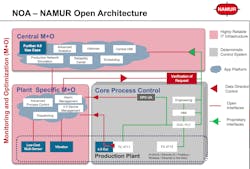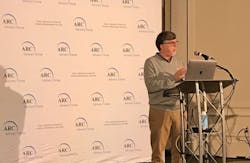New Process Information Model and Two-Wire Ethernet Protocol Coming Soon
At the ARC Forum 2020, Paul Sereiko and Ted Masters of the FieldComm Group gave a preview of the forthcoming NAMUR Open Architecture Information Model (NOA-IM) and the role FieldComm Group is playing to help tailor the specification for use in process automation applications.
NAMUR states that the basic idea of its open architecture is to provide an open interface between the existing core process control domain and the monitoring and optimization domain. Though this architecture allows for a second communication channel to directly access information from existing field devices, the process control core remains largely unaffected.
“To ensure interoperability and seamless access to device information, it is necessary to standardize on the form and basic contents of the information models for certain device classes independent of a specific communication protocol,” the FieldComm Group states. “The enormous installed base in the process industries requires a solution that can make use of information from devices communicating via current field communication solutions such as HART, Foundation Fieldbus, and Profibus PA, each of which employs different software structures to represent the same information. Information models (like NOA-IM) are needed to provide seamless and interoperable access for software applications and other devices.”
According to Profibus/Profinet International, PA-DIM (developed jointly by the FieldComm Group, OPC Foundation, and Profibus/Profinet International) is a protocol-agnostic, unified information model that allows software applications to access device information without additional mapping or protocol-specific knowledge. It is based on the NAMUR requirements for open architecture, self-monitoring, and diagnosis of field devices. PA-DIM covers use cases such as: providing/receiving information to/from HMIs; providing interfaces for configuring the security of a device and monitoring its current hardening status; and providing information for device dashboards, information and reporting apps, inventory management and remote monitoring applications, real-time control applications, and device configuration and parameterization.
“PA-DIM was announced at the ARC Forum in 2018 and had its proof of concept verified by NAMUR in 2019,” said Masters. “The final specification will be released in first quarter of 2020, with the first field devices supporting it expected to be released in 2021.” He added that FieldComm Group’s role in this process has been working with groups such as ODVA, PNO (Profibus/Profinet User Organization), Open Process Automation Forum (OPAF), and the OPC Foundation around standards developed to serve the process automation industry and suppliers.
In addition to NOA-IM and PA-DIM, Sereiko and Masters highlighted the importance of the emerging two-wire Ethernet protocol known as the Ethernet Advanced Physical Layer (APL) Project. Sereiko said this protocol is designed to bring Ethernet to field level devices with particular attention being paid to process industry-specific safety factors.
Sereiko said Ethernet-APL can run multiple protocols over a single two-wire cable. “It is intrinsically safe too,” he added.
Recently Automation World covered the creation of the SPE (Single Pair Ethernet) Industrial Partner Network. SPE enables the transmission of data over Ethernet using only two copper wires, with simultaneous power supply for terminals delivered via PoDL (power over data line). When asked about overlap between Ethernet-APL and SPE, Serieko said that both “share the IEEE physical layer, but what’s unique about Ethernet-APL is its intrinsic safety capability. Ethernet-APL is more specific to process automation where SPE is for cross-industry application,” he said.
As with PA-DIM, Profibus/Profinet International, FieldComm Group, and ODVA are all cooperating on Ethernet-APL. Some of the major goals of this collaboration include:
- Expansion of the IEEE 802.3cg (10BASE-T1L) Ethernet standard to specify two-wire Ethernet with segment lengths of up to 1,000 meters, a transmission rate of 10 Mbit/s, and optional power supply over the same cable;
- Specification of port profiles for the power supply;
- Expansion of the IEC specification to include explosion-protection methods for intrinsic safety (2WISE, or 2-Wire Intrinsically Safe Ethernet);
- Integration of the option for 10BASE-T1L into the protocol-specific specifications;
- Planning and installation guidelines; and
- Test standards.
Ethernet-APL work packages and specifications are expected to be completed before the end of 2021, with the first Ethernet-capable field devices for hazardous environments available soon afterward.
Beyond the industrial networking protocol organizations working on Ethernet-APL, Masters noted industry support for this initiative from ABB, Emerson, Endress+Hauser, Krohne, Pepperl+Fuchs, Phoenix Contact, Rockwell Automation, Samson, Siemens, Stahl, Vega, and Yokogawa.


